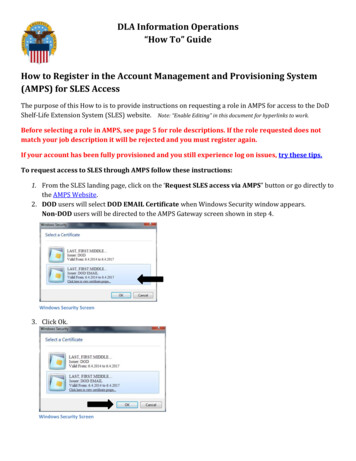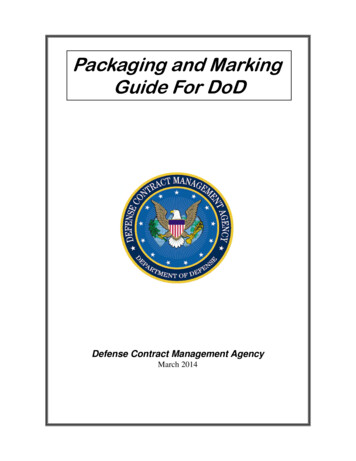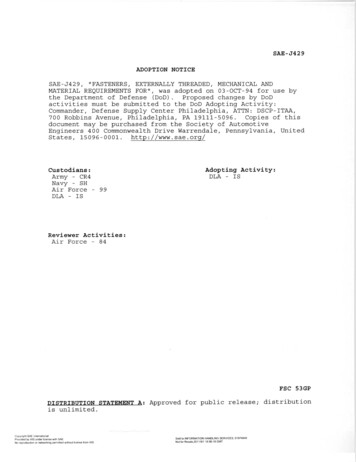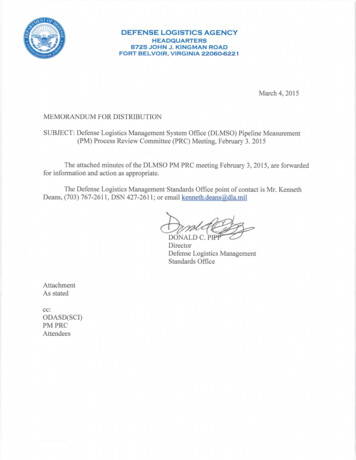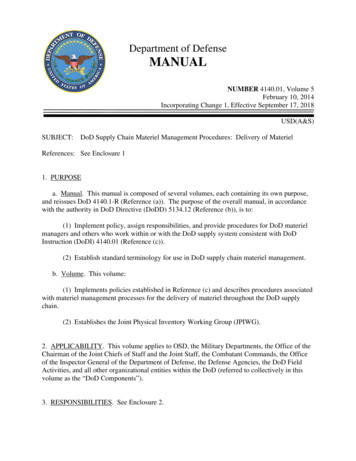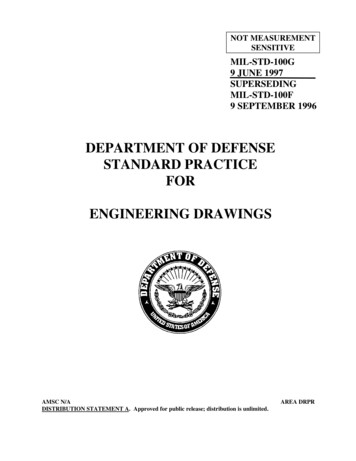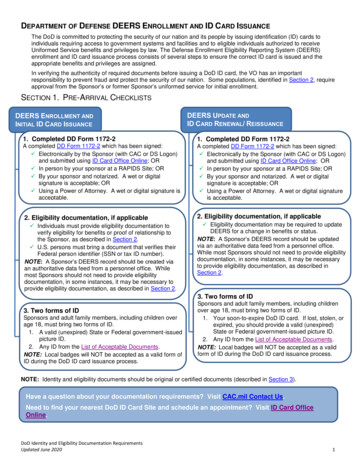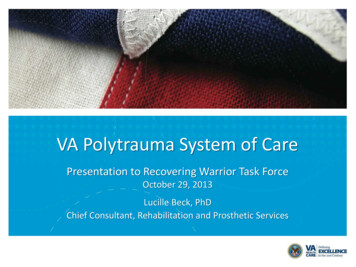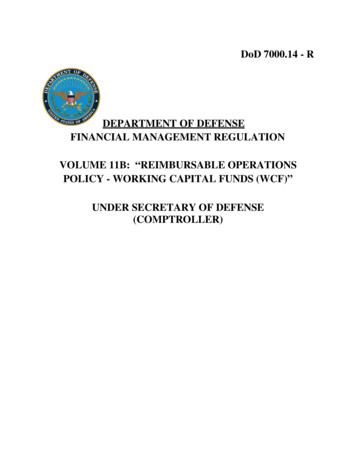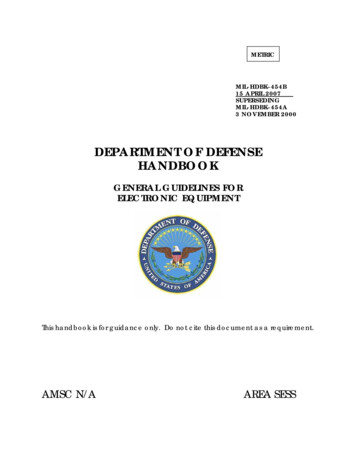
Transcription
METRICMIL-HDBK-454B15 APRIL 2007SUPERSEDINGMIL-HDBK-454A3 NOVEMBER 2000DEPARTMENT OF DEFENSEHANDBOOKGENERAL GUIDELINES FORELECTRONIC EQUIPMENTThis handbook is for guidance only. Do not cite this document as a requirement.AMSC N/AAREA SESS
MIL-HDBK-454BFOREWORD1. This handbook is approved for use by all Departments and Agencies of the Department of Defense2. This handbook is for guidance only. This handbook cannot be cited as a requirement. If it is, the contractor doesnot have to comply.3. This handbook is the technical baseline for the design and construction of electronic equipment for the Departmentof Defense. It captures in one document, under suitable subject heading, fundamental design guidelines for multiplegeneral electronic specifications. The opportunity to focus on a single document, afforded to contractors, results insubstantial savings to the Government. This handbook was prepared by, and is regularly updated through, thecooperative efforts of Government and industry. The documents listed below are not necessarily all of the documentsreferenced herein, but are those needed to understand the information provided by this K-2036Electronic Equipment, Aerospace, Extended Space Environment,General Specification for.Fire Control Equipment, Naval Ship and Shore, General Specification for.Test Equipment for Use with Electrical and Electronic Equipment,General Specification for.Electronic Equipment Specifications, Preparation of.4. Comments, suggestions, or questions on this document should be addressed to (Defense Supply Center,Columbus, ATTN: DSCC-VSC, P.O. Box 3990, Columbus, OH 43218-3990) or emailed to(mailto:DSCC.PartsSupport@dla.mil). Since contact information can change, you may want to verify the currency ofthis address information using the ASSIST Online database at http://assist.daps.dla.mil.ii
2.11.31.4SCOPEGuidelines applicable to electronic equipmentRevision of guidelinesRedatingMethod of referenceInterrelationship of guidelines1111112.2.12.2APPLICABLE DOCUMENTSIndividual guidelinesIndustry addresses1113.3.13.2DEFINITIONSAirborne, space, aerospaceOther terms are defined in the individual guidelines3334.4.14.2GENERAL GUIDELINESApplicationUse of selection and application standards3335.DETAIL GUIDELINESIndividual guidelines for electronic equipment see section36.6.16.2333NOTESSubject term (key word) listingChanges from previous issueiii
MIL-HDBK-454BCONTENTSINDIVIDUAL GUIDELINESGuideline 1Guideline 2Guideline 3Guideline 4Guideline 5Guideline 6Guideline 7Guideline 8Guideline 9Guideline 10Guideline 11Guideline 12Guideline 13Guideline 14Guideline 15Guideline 16Guideline 17Guideline 18Guideline 19Guideline 20Guideline 21Guideline 22Guideline 23Guideline 24Guideline 25Guideline 26Guideline 27Guideline 28Guideline 29Guideline 30Guideline 31Guideline 32Guideline 33Guideline 34Guideline 35Guideline 36Guideline 37Guideline 38Guideline 39Guideline 40Guideline 41Guideline 42Guideline 43Guideline 44Guideline 45Guideline 46Guideline 47Guideline 48Guideline 49Guideline 50Guideline 51Guideline 52Guideline 53Guideline 54TITLESafety Design Criteria - Personnel HazardsCapacitorsFlammabilityFungus Inert ical Overload ProtectionWorkmanshipElectrical ConnectorsInsulating Materials, ElectricalFastener HardwareStructural WeldingTransformers, Inductors, and CoilsMetals, Corrosion ResistanceDissimilar MetalsPrinted WiringDerating of Electronic Parts and MaterialsTerminationsWire, Hookup, InternalCastingsParts ManagementAdhesivesWelds, Resistance, Electrical InterconnectionsElectrical PowerArc-Resistant MaterialsBatteriesControlsElectron TubesSemiconductor DevicesMoisture PocketsTest ilityCircuit BreakersQuartz Crystals and Oscillator UnitsFuses and Fuse HoldersShuntsSpringsTuning Dial MechanismsLubricantsFibrous Materials, OrganicCorona and Electrical Breakdown PreventionMotors and Rotary Power ConvertersEncapsulation and Embedment (Potting)GearsHydraulicsIndicator LightsMeters, Electrical IndicatingThermal DesignWaveguides and Related DevicesMaintainabilityiv
MIL-HDBK-454BCONTENTSINDIVIDUAL GUIDELINESGuideline 55Guideline 56Guideline 57Guideline 58Guideline 59Guideline 60Guideline 61Guideline 62Guideline 63Guideline 64Guideline 65Guideline 66Guideline 67Guideline 68Guideline 69Guideline 70Guideline 71Guideline 72Guideline 73Guideline 74Guideline 75Guideline 76Guideline 77Guideline 78TITLEEnclosuresRotary Servo DevicesRelaysSwitchesBrazingSockets and AccessoriesElectromagnetic Interference ControlHuman EngineeringSpecial ToolsMicroelectronic DevicesCable, Coaxial (RF)Cable, MulticonductorMarkingReadouts and DisplaysInternal Wiring PracticesElectrical FiltersCable and Wire, InterconnectionSubstitutabilityStandard Electronic ModulesGrounding, Bonding, and ShieldingElectrostatic Discharge ControlFiber OpticsIntegrated DiagnosticsProducibilityTABLESTable 1-I.Table 1-II.Table 4-I.Table 10-I.Table 20-I.Table 21-I.Table 26-I.Table 41-I.Table 41-II.Table 41-III.Table 50-I.Table 53-I.Table 66-I.Table 69-I.Table 71-I.Table 71-II.Probable effects of shock.Suitable protective measures.Fungi-susceptibility of materials.Abbreviations for thermocouple materials.Wire, electrical.General comparison of metallic casting processes.Arc-resistant materials.Materials for electrical spring application.Corrosion resisting steel for springs.Carbon steel for springs.Indicator lights and associated items.Waveguides and related devices.Cable, multiconductor.Electrical clearance and leakage (creepage) distances.Wire, electrical, interconnection.Cable, multiconductor, interconnection.INDEXCONCLUDING MATERIALv
MIL-HDBK-454B1. SCOPE1.1 Guidelines applicable to electronic equipment. This handbook provides guidance and lessons learned in theselection of documentation for the design of electronic equipment. This handbook is for guidance only and cannot becited as a requirement. If it is, the contractor does not have to comply.1.2 Revision of guidelines. Revisions of individual guidelines are indicated by a date below the guidelinenumber located at the bottom of the page. When the basic document is revised, those guidelines not affected bychange retain their existing date.1.2.1 Redating. Although individual guidelines are reviewed and updated or validated at least once everyeighteen months, guidelines are not redated unless technical changes are made.1.3. Method of reference. Guidelines contained herein should be referenced by specifying this handbook andthe guideline number for guidance only.1.4 Interrelationship of guidelines. Each guideline is intended to cover some discipline in the design ofequipment, such as a procedure, a process, or the selection and application of parts and materials. Many of thesedisciplines, however, cannot retain a clear-cut separation or isolation from others so that when guidelines ofMIL-HDBK-454 are referenced in a specification some guidelines will undoubtedly have a direct interrelationship withother guidelines. This interrelationship should be taken into consideration when referencing these guidelines.2. APPLICABLE DOCUMENTS.2.1 Individual guidelines. See section 2 of each individual guideline for a listing of applicable documents.Documents referenced in the individual guidelines apply to the extent specified herein.(Copies of these documents are available online at http://assist.daps.dla.mil/quicksearch/ orhttp://assist.daps.dla.mil or from the Standardization Document Order Desk, 700 Robins Avenue, Building 4D,Philadelphia, PA 1911-5094.)2.2 Industry addresses. Addresses for obtaining documents referenced in the guidelines but not obtainablefrom the Government are as follows:1
MIL-HDBK-454BSymbolAddressAGMAAmerican Gear Manufacturers’ Association1500 King Street, Suite 12Arlington VA 22314AIAAerospace Industries Association1000 Wilson Boulevard, Suite 1700Arlington, VA 22209-3928AMSARPSociety of Automotive Engineers, Inc.400 Commonwealth DriveWarrendale PA 15096ANSIAmerican National Standards Institute11 West 42nd StreetNew York NY 10036ASMEAmerican Society of Mechanical Engineers22 Law Drive P.O. Box 2900Fairfield NJ 07007-2900ASMAmerican Society for MetalsMetals Park OH 44073ASTMAmerican Society for Testing and Materials100 Barr Harbor DriveWest Conshohockan PA 19428-2959AWSAmerican Welding Society550 NW LeJeune RoadMiami FL 33126EIAElectronic Industries Alliance2500 Wilson Blvd.Arlington VA 22201-3834GEIAGovernment Electronics and Information Association777 East Eisenhower ParkwayAnn Arbor, MI, USA 48108IEEEInstitute of Electrical and Electronics EngineersIEEE Service Center445 Hoes LanePO Box 1331Piscataway NJ 08855-1331IPCInstitute for Interconnecting and Packaging Electronic Circuits2215 Sanders Rd. Suite 200 SouthNorthbrook IL 600622
MIL-HDBK-454BNASNational Standards Association1200 Quince Orchard BoulevardGaithersburg MD 20878NFPANational Fire Protection AssociationBatterymarch ParkQuincy MA 02269-9101ULUnderwriters Laboratories, Incorporated333 Pfingsten RoadNorthbrook IL 600623. DEFINITIONS3.1 Airborne, space, aerospace. "Airborne" denotes those applications peculiar to aircraft and missile or othersystems designed for operation primarily within the earth's atmosphere; "space" denotes application peculiar tospacecraft and systems designed for operation near or beyond the upper reaches of the earth's atmosphere; and"aerospace" includes both airborne and space applications.3.2 Other definitions and terms. Other definitions and terms are defined in the individual guidelines4. GENERAL GUIDELINES4.1 Application. The guidelines contained herein are intended to provide uniform guidelines applicable toelectronic equipment, unless otherwise specified in the guideline.4.2 Use of selection and application standards. When a selection and application standard is invoked in aguideline, the devices or parts selected should conform to the applicable military specifications referenced in thestandard.5. DETAIL GUIDELINES5.1 Individual guidelines for electronic equipment. The individual guidelines for electronic equipment arelocated after section 6.6. NOTES6.1 Subject term (key word) listing.Cable selectionCorona protectionEncapsulationFastenersFlammabilityFungus protectionInterchangeability of partsMarkingMaterials selectionMicroelectronicsNomenclatureParts selectionPrinted wiringSafetySolderingSubstitutability of partsThermal designWaveguidesWire selectionWorkmanship6.2 Changes from previous issue. Marginal notations are not used in this revision to identify changes withrespect to the previous issue due to the extent of the changes.3
MIL-HDBK-454BGUIDELINE 1SAFETY DESIGN CRITERIA - PERSONNEL HAZARDS1. Purpose. This guideline establishes safety design criteria and provides guidelines for personnel protection.2. Applicable documents. The documents listed below are not necessarily all of the documents referenced herein,but are those needed to understand the information provided by this D-1472DOD Manual 6050.510 CFR 2021 CFR 1000-105029 CFR 1910ANSI N2.1ANSI Z136.1ASTM F 1166IEEE C95.1IEEE C95.2NEMA Z535.1NEMA Z535.2NEMA Z535.3NEMA Z535.4NEMA Z535.5NFPA 70Electromagnetic Environmental Effects Requirements for Systems.Shipboard Bonding, Grounding, and Other Techniques forElectromagnetic Compatibility and Safety.Safety Design Requirements for Military Lasers and Associated Support Equipment.Human Engineering.DoD Hazardous Materials Information System Procedure.Code of Federal Regulations, Title 10, Chapter I, Part 20.Code of Federal Regulations, Title 21, Chapter I, Parts 1000-1050.Code of Federal Regulations, Title 29, Chapter XVII, Part 1910.Radiation Symbol.Safe Use of Lasers.Standard Practice for Human Engineering Design for Marine Systems,Equipment and Facilities.Standard for Safety Levels with Respect to Human Exposure to RadioFrequency Electromagnetic Fields, 3 kHz to 300 GHz.Radio-Frequency energy and current flow Symbols.Safety Colors.Environmental and Facility Safety Signs.Criteria for Safety Symbols.Product Safety Signs and Labels.Safety Tags and Barricade Tapes (for Temporary Hazards).National Electrical Code.3. Definitions.3.1 Battleshort. A switch used to bypass normal interlocks in mission critical equipment; (e.g., equipment whichmust not be shut down or the mission function will fail) during battle conditions.3.2 Chassis, electrical equipment. The chassis is a structural item fabricated in such manner as to facilitateassemblage and interconnection of electrical or electronic items for the specific purpose of providing a basis forelectrical or electronic circuits. It normally has drilled or stamped holes to accommodate the items but may includeonly the items necessary for its own mounting and support.3.3 Commercial off-the-shelf (COTS) equipment. COTS equipment that can be purchased through commercialretail or wholesale distributors as is (e.g., equipment that is available as a cataloged item) or with only minormodifications that does not alter its form, fit, or functional characteristics.3.4 Frame. The frame is any construction system fitted and united together, designed for mounting or supportingelectrical or electronic parts or units.3.5 Fail-safe. The design feature of a part, unit, or equipment which allows the item to fail only into a nonhazardous mode.3.6 Interlock. An interlock is an automatic switch which eliminates all power from the equipment when an accessdoor, cover, or plate is removed.3.6.1 Bypassable interlock. A bypassable interlock is an automatic switch with a manually operated electricalbypass device to allow equipment maintenance operations on energized equipment.1-1
MIL-HDBK-454BGUIDELINE 13.7 Leakage current. Leakage current is that current which flows through the equipment conductive paths to asolidly grounded source.3.8 Pro
MIL-HDBK-454B 15 APRIL 2007 SUPERSEDING MIL-HDBK-454A 3 NOVEMBER 2000 DEPARTMENT OF DEFENSE HANDBOOK GENERAL GUIDELINES FOR ELECTRONIC EQUIPMENT This handbook is for guidance only. Do not cite this document as a requirement. AMSC N/A AREA SESS METRIC. MIL-HDBK-454B FOREWORD ii 1. This handbook is approved for use by all Departments
